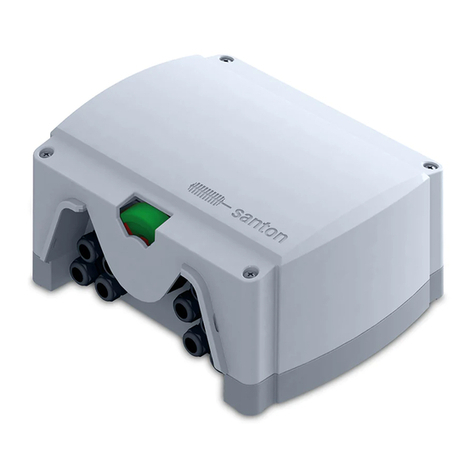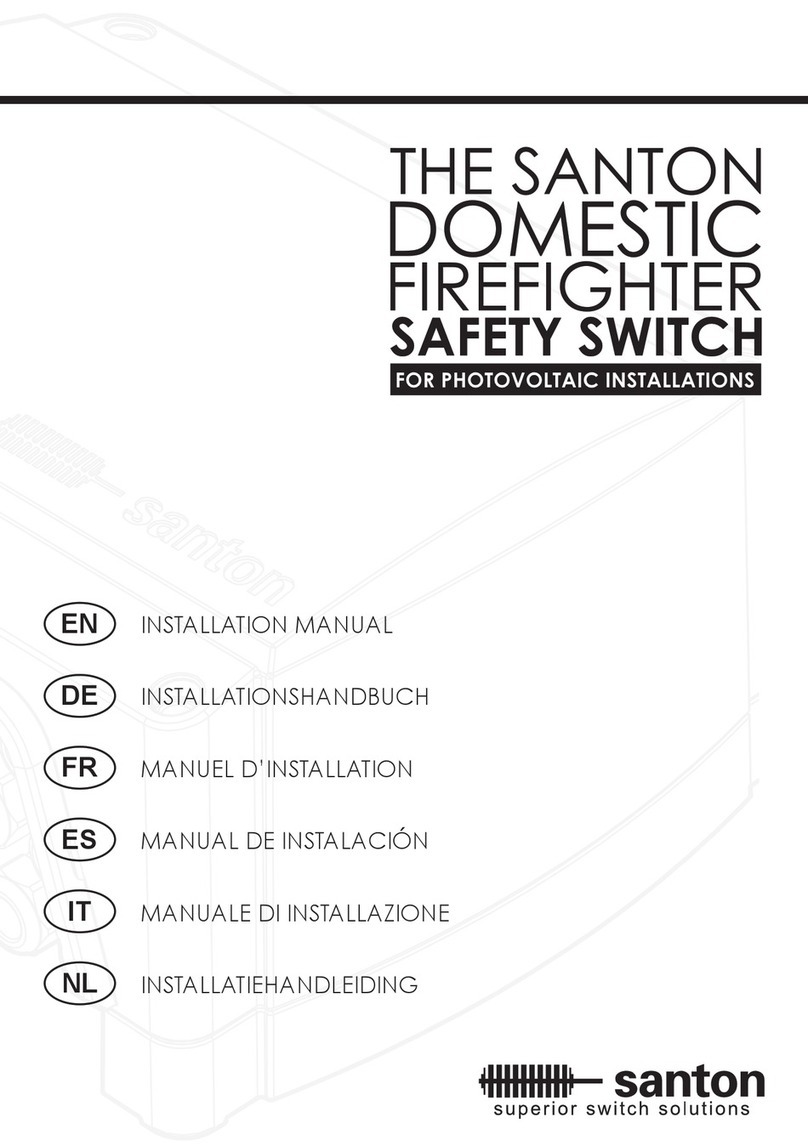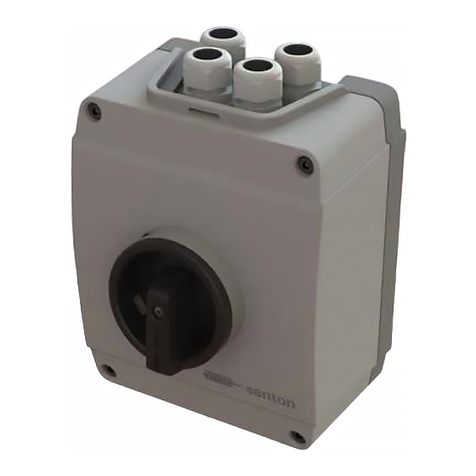
FIREFIGHTER SAFETY SWITCH
SAFETY PRECAUTIONS
2 3
Important safety precautions
Attention! Components in the installations are exposed to high voltages and currents. Follow these instructions carefully in order to
reduce the risk of re or electric shock.
The following regulations and standards are considered applicable and mandatory to read prior to the installation of electrical equipment:
• International Standards: IEC 60364-7-712 Electrical installations of buildings – Requirements for special installations or locations – Solar
Photovoltaic (PV) power supply systems
• MIS3002: Microgeneration Installation Standard - requirements for contractors undertaking the supply, design, installation, set to work
commissioning and handover of solar photovoltaic (PV) microgeneration systems
• Local building regulations and local legislation at the time of installation
• Guidelines for lightning and overvoltage protection
Note!
• It is essential to uphold the limits for voltage and current in all possible operating conditions (see page 7; ‘Technical Data’).
Also keep in mind the literature on correct dimensioning and sizing of cabling and components.
• The installation of these devices may only be performed by certied technical personnel.
• All the installation works should be tested in accordance with relevant local legislation at the time of installation.
Importantes Medidas De Seguridad
¡Atención! Los componentes de la instalación están expuestos a corrientes de alto voltaje. Siga atentamente estas instrucciones para
reducir el riesgo de incendio o descarga eléctrica.
Hay que tener en cuenta los siguientes reglamentos y normas. Léalos detenidamente antes de instalar el equipo eléctrico:
• Normas internacionales: IEC 60364-7-712 Instalaciones eléctricas en edicios – Requisitos para las instalaciones y emplazamientos
especiales – Sistemas de alimentación de energía solar fotovoltaica
• Normas urbanísticas locales y legislación local en el momento de la instalación
• Pautas de protección contra rayos y sobretensiones
Nota!
• Es fundamental que respete los límites de voltaje y corriente en todas las condiciones de funcionamiento posibles (véase páginas 7;
“Datos técnicos”).Tenga en cuenta la información sobre el tamaño y dimensionamiento correctos de cables y componentes.
• La instalación de estos dispositivos solo debe llevarse a cabo por personal técnico cualicado.
• Todos los trabajos de instalación deben comprobarse de acuerdo con la legislación local pertinente en el momento de la instalación.
Wichtige Sicherheitsvorkehrungen
Achtung! Bauteile der Anlagen werden hohen Spannungen und Strömen ausgesetzt. Halten Sie sich an diese Anweisungen, um das
Risiko eines Feuers oder Stromschlags zu minimieren.
Es gelten die folgenden Vorschriften und Normen. Diese müssen durchgelesen werden, bevor elektrische Geräte installiert werden:
• Internationale Standards: IEC 60364-7-712 Elektrische Anlagen von Gebäuden - Anforderungen bei besonderen Anlagen oder Standorten
- Solar Photovoltaik-(PV) Stromversorgungssysteme
• Lokale Vorgaben: - DIN VDE 0100 - Errichten von Niederspannungsanlagen
- VDI 6012 - Dezentrale Energiesysteme im Gebäude, Photovoltaik
- BGV A1 - Allgemeine Vorschriften
- BGV A2 - Elektrische Anlagen und Betriebsmittel
• Richtlinien für den Blitz- und Überspannungsschutz
Anmerkung!
• Die angegeben Grenzen für Spannung und Strom sind unbedingt in allen möglichen Betriebszuständen einzuhalten (siehe Seite 7;
Technische Angaben“).Beachten Sie bitte auch die Fachliteratur über die richtige Auslegung und Dimensionierung von Kabeln und
Komponenten.
• Die Installation dieser Geräte darf nur von entsprechend geschultem Fachpersonal durchgeführt werden.
• Die gesamten Installationsarbeiten müssen anhand der entsprechenden lokalen Vorschriften zum Zeitpunkt der Installation überprüft
werden.
Important safety precautions
Attenzione! I componenti delle installazioni sono esposti a tensioni e correnti elevate; seguite scrupolosamente queste istruzioni per
ridurre il rischio di incendi ed elettrocuzioni.
Segue l’elenco delle norme e dei regolamenti pertinenti, che dovete leggere prima di installare l’apparecchiatura elettrica:
• Norme internazionali: IEC 60364-7-712 Installazioni elettriche degli edici – Regolamentazioni per installazioni e aree speciali – Sistemi di
alimentazione fotovoltaici
• Normative locali sugli edici e legislazione vigente al momento dell’installazione
• Istruzioni di protezione contro i fulmini e le sovratensioni
Nota!
• È essenziale rispettare i limiti di tensione e corrente in tutte le possibili condizioni di funzionamento (vedere le pagine 7, “Dati tecnici”).
Dovete inoltre attenervi anche alla documentazione in materia di corretto dimensionamento dei cavi e dei componenti.
• L’installazione di questi dispositivi deve essere eseguita esclusivamente da personale tecnico addestrato.
• Tutte le opere di installazione devono essere collaudate in conformità alla legislazione vigente al momento dell’installazione.
Mesures de sécurité importantes
Attention! Les éléments des installations sont exposés à de hautes tensions et intensités. Veuillez suivre attentivement ces instructions
pour réduire le risque d’incendie ou d’électrochoc.
Les réglementations et normes suivantes s’appliquent. Il faut les lire avant l’installation du matériel électrique :
• Normes internationales : IEC 60364-7-712 : Installations électriques des bâtiments – Règles pour les installations et emplacements
spéciaux – Alimentations photovoltaïques (PV) solaires
• Réglementations locales et législation locale concernant les bâtiments en vigueur au moment de l’installation
• Directives sur l’éclairage et la protection contre la surtension
Remarque!
• Il faut impérativement respecter les limites imposées de tension et d’intensité dans toutes les conditions d’exploitation (voir page 7,
‘Caractéristiques techniques’). Il convient aussi de tenir à l’esprit les publications concernant le dimensionnement et la détermination des
tailles des câblages et des éléments des installations.
• L’installation de ces dispositifs doit être strictement réservée à un personnel technique ayant suivi une formation adaptée.
• Il faut tester le fonctionnement de tous les éléments de l’installation conformément à la législation locale en vigueur au moment de
l’installation.
Belangrijke voorzorgsmaatregelen
Let op! Componenten in de installatie staan blootgesteld aan hoge spanning en stroomsterktes. Volg deze instructies met zorg op om het
risico op brand of een elektrische schok te verminderen.
De volgende regels en normen zijn van toepassing. Het is belangrijk deze door te lezen alvorens de elektrische apparatuur te installeren:
• Internationale normen: IEC 60364-7-712: Elektrische installaties van gebouwen: bepalingen voor bijzondere installaties of locaties -
fotovoltaïsche (PV) voedingssystemen
• Lokale voorschriften voor gebouwen en lokale wetgeving op het moment van installatie
• Richtlijnen voor bescherming tegen bliksem en overspanning
Opmerking!
• Het is essentieel om de grenzen voor spanning en stroomsterkte in alle mogelijke bedrijfssituaties te handhaven
(zie pagina 7, ‘Technische gegevens’). Bekijk ook de literatuur over de juiste maten en afmetingen van kabels en componenten.
• De installatie van deze apparaten mag alleen worden uitgevoerd door geschoold technisch personeel.
• Alle werkzaamheden ten behoeve van de installatie dienen getest te worden in overeenstemming met de relevante lokale wetgeving ten
tijde van de installatie.
EN ES
DE IT
FR NL






























